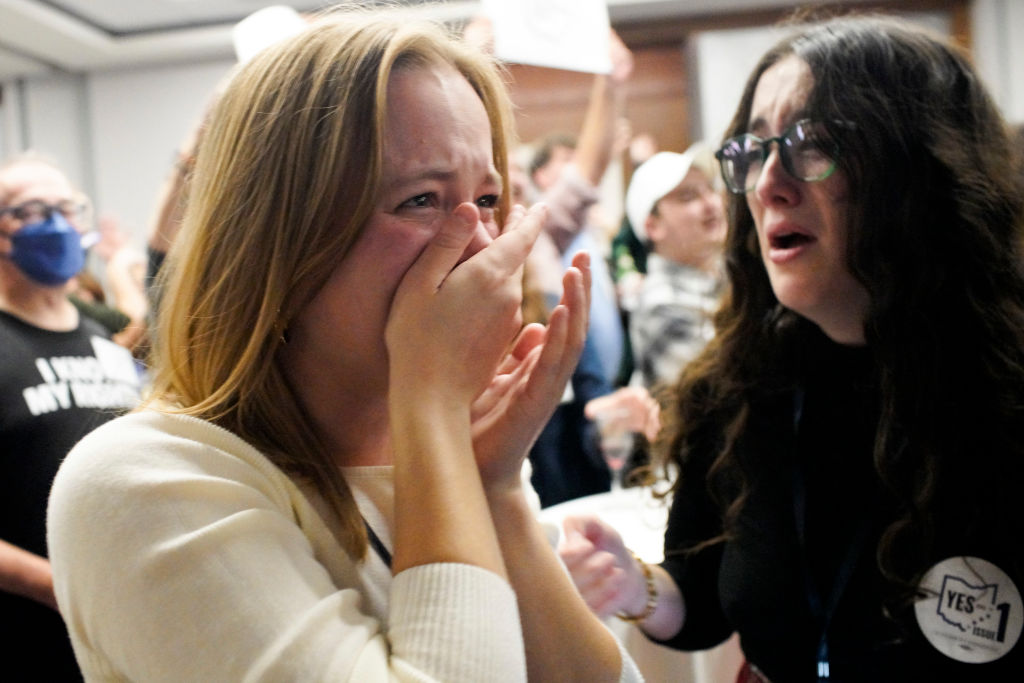Organizing and social change movements are far ahead of their funders in moving from cooperation to solidarity. To turn back the tide of authoritarianism, philanthropy must follow their lead.

This essay is part of a Women & Democracy package focused on who’s funding the women and LGBTQ people on the frontlines of democracy. We’re manifesting a new era for philanthropy—one that centers feminism. The need is real: Funding for women and girls amounts to less than 2 percent of all philanthropic giving; for women of color, it’s less than 1 percent. Explore the “Feminist Philanthropy Is Essential to Democracy” collection.
A roaring chant of marches and movements, the phrase “this is what democracy looks like!” encapsulates the spirit of protest, solidarity and civic power in action.
Democracy has long been an elusive concept to most voters—an idea so theoretical and technical that its pursuit primarily remained the purview of the ivory tower. Discussed and debated among academics and foundation leaders, philanthropic investments have supported systems, rather than values relevant to the masses.
Today, “this is what democracy looks like!” serves as much as a rallying cry as it does a signal of a movement’s rebirth. This phrase is raised on campuses, at the polls, and among multi-racial, multi-generational coalitions in states across the country.
The demand for a rebirth of democracy has ricocheted back to the halls of power. Institutional funders now acknowledge groups on the frontline of reproductive freedom as “saving democracy.” (Have you heard? Headline after headline tout “Abortion Wins Elections.”)
In this new civic reality, rallying, knocking on doors and collecting signatures is the new normal. Voters have found themselves wondering how Roe v. Wade fell. They respond to pollsters that abortion is the cause that now motivates them to participate and that democracy itself is in peril. Their immediate response is to volunteer en masse.
In Michigan, signatures were collected in record numbers to qualify, and eventually pass, a ballot measure enshrining the right to an abortion to the state Constitution. And in Kansas, there was an attempt to usurp the state Supreme Court, following its ruling that the state Constitution protects the right to an abortion.
Across the country, people have joined the effort to restore, protect and defend abortion. Reproductive and bodily autonomy has inspired voters across ideology, across party and across generations to show up and shout, “This is what democracy looks like!”
Pro-democracy philanthropy has historically struggled to find a story that fully and persuasively demonstrates the rising threat of authoritarianism. Since the fall of Roe, it is reproductive rights funders who now bring the receipts. It is our grantees’ work that makes the case.
But the philanthropic sphere still has a long road ahead. Reproductive and gender rights organizations continue to be treated as “issue groups” rather than power building organizations and force-multipliers for democratic engagement. At the Gender Equity Action Fund where I work, we still hear from grantees that they cannot convince democracy-focused funders that their efforts are essential to building a healthy democracy.
The struggle to make a case for funding reminds me of a powerful passage from Hernan Diaz’s novel, Trust. Diaz grasps a far grander truth and points the way forward:
“Get enough selfish individuals to converge and act in the same direction, and the result looks very much like a collective will or a common cause. But once this illusory public interest is at work, people forget an all-important distinction: that my needs, desires and cravings may mirror yours does not mean we have a shared goal. It merely means we have the same goal.”
He warns of this crucial difference: “There’s nothing heroic about defending other people’s interests just because they happen to coincide with yours. Cooperation, when its objective is personal gain, should never be confused with solidarity.”
Diaz’s necessary distinction between “same goals” and “shared goals” informs contemporary democracy. In states like Ohio, pro-democracy and reproductive rights funders cooperated in investing in direct democracy initiatives, yet did not support abortion rights just months later.
Meanwhile, the Ohio Organizing Collaborative, a group fueling the 2024 ballot measure in support of an independent redistricting committee, understands the inherent value in building lasting power together with the Ohio Women’s Alliance and the strength that comes with solidarity across and within movements.
In Ohio and elsewhere, organizing and social change movements are far ahead of their funders in moving from cooperation (“same goals”) to solidarity (“shared goals”). To turn back the tide of authoritarianism, philanthropy must follow their lead. Moving from cooperation to solidarity will ultimately be how we demonstrate exactly what democracy looks like.
Think investing in women is essential to democracy? We do too. Sign up for our daily or weekly emails to hear from (and join!) the feminist philanthropists funding the future. (We heard alliteration is back in style.) Or go back to the essay collection.






